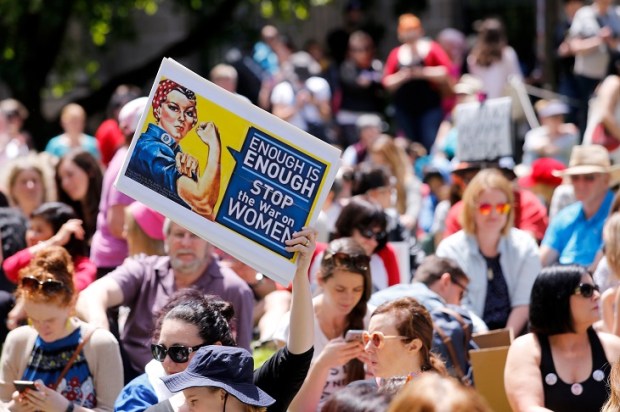Since the Australian Bureau of Statistics (ABS) released its publication on partner violence, the widely reported statistic is that one in five Australians (21 per cent) have been subjected to partner violence or abuse.
This is an average of men and women. The ABS estimates the prevalence of partner violence or abuse of women is higher, 27 per cent, which is approaching one-third.
The 27 per cent figure captures three sorts of abuse. The first is physical violence, such as a kick or a hit. The second is economic abuse, and the third is emotional abuse.
It is estimated that 17 per cent of women over 18 years of age have experienced some form of violence since the age of 15.
Around 23 per cent have experienced emotional abuse and 16 per cent economic abuse. Because some women have experienced more than one type, the figures cannot be added. So, the 27 per cent represents the total number of impacted women subjected to violence or abuse.
The ABS does not weight the importance or criticality of abuse types. It could be argued that physical abuse is more serious than other forms, yet there are likely to be many examples of where economic or emotional abuse has caused more pain and suffering than that of physical attacks. On this rationale, the ABS decision to aggregate three forms of abuse into one overall prevalence estimate seems reasonable.
Where I believe the ABS has made more questionable decisions is in regard to the definitions of violence and abuse, specifically it not only includes cases of ‘actual’ violence or abuse, but also ‘threats’ and ‘attempts’ at abuse.
In my mind, I’ve never been subjected to physical abuse from a partner. But I once had a girlfriend aim a kick at my head. We were playing a game of Monopoly and when she rolled a ‘three’ on the dice, which obligated her to move her thimble onto Park Lane, which I owned.
I had just invested in the property, putting on a hotel. When she landed on it, rather than paying the rent, she tried to kick me in the head and, luckily, missed.
Her attempted kick would be caught in the ABS’s definition of violence, even though it didn’t hurt or cause any lasting physical including emotional scars.
The ABS classifies as ‘economic abuse’ situations such as where someone ‘tried’ to control them from having access to household money. Or they ‘tried’ to prevent them from studying.
Similarly with the category of ‘emotional abuse’, the ABS includes situations where a partner ‘tried’ to control them from contacting family; tried to stop them using a telephone, internet or family car; tried to control where they went or who they saw.
The key word here is ‘tried’. By definition, it means the partner failed to achieve the outcome. The partner’s behaviour is wrong and not pleasant, and made much worse if the attempts are repetitive, yet it is short of what most people would consider abuse. And a definition that remains open to misinterpretation.
In football, sledging and attempts to covertly injure an opponent are common, but it is not until someone actually throws and lands a punch that severe penalties are actively enforced.
This decision regarding the survey parametres probably skewed the abuse figures of females relative to males. At least, that is my opinion.
For example, emotional abuse behaviours include ‘shouting or yelling’ to intimidate, yet it explicitly excludes cases of ‘nagging’.
Nagging is characteristically used to describe a behaviour of women more than men. This is why there are so many culturally based jokes about women nagging men, to cut lawns, spend less money on hobbies, play less golf, drink less beer, watch less TV, etc.
Nagging is a form of manipulation, a drip-drip-type torture, a means of controlling what people do, and primarily impacts males. And it can make people miserable.
The other curious sex-based behaviour not cited by the ABS in its definition is that delicate and thorny issue of sexual manipulation.
Once again, there is a well-recognised cultural practice where a female partner can manipulate a man by withholding sex until he acts in a way that accords with what the woman wants. The motivation for the manipulation can be a major or minor issue. Under Sharia Law, wives cannot refuse sex with their husband.
Of course, there should be no legal compulsion in Western countries on women to provide sexual services, but it is a major issue in many relationships and a key cause of distress for men, so in my opinion it should have been explicitly listed as a potential source of abuse by the ABS.
Possibly a third issue for abuse should be the situation where a false allegation that a parent or de-facto partner has hurt a child, as is commonly used as a means of securing a more favourable divorce custody and financial settlement. These allegations can be emotionally devastating for the accused.
If nagging, sex manipulation, and false allegations in divorce proceedings were to be made explicit as sources of abuse, then the ABS aggregated abuse numbers would almost certainly be more balanced across the sexes.
Given the importance of the ABS as a critical institution and supplier of important information essential for public policy formulation, it is a shame partner violence statistics seem to fall somewhat short of ideal data collection expectations.
Nick Hossack is a public policy consultant. He is former policy director at the Australian Bankers’ Association and former adviser to Prime Minister John Howard.

























